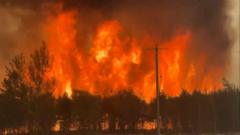With over 180 wildfires reported across Canada, Manitoba officials are using military resources to evacuate residents from the rapidly spreading blazes. The situation is exacerbated by dry conditions and high winds, with air quality warnings extending to parts of the United States.
Military Aircraft Mobilized as Wildfires Threaten Manitoba Residents

Military Aircraft Mobilized as Wildfires Threaten Manitoba Residents
As wildfires rage across Western Canada, military aircraft and helicopters are executing evacuations in Manitoba, where thousands face dangerous conditions.
Military aircraft and helicopters have taken a central role in the evacuation efforts of residents in Manitoba as the region grapples with a series of fast-moving wildfires. Over 180 active wildfires have been recorded in Canada, with Saskatchewan and Manitoba experiencing the most severe impacts. Following a state of emergency declared by both provinces, officials have sought international aid to help combat the raging fires.
Recent aerial footage has revealed alarming smoke plumes resulting from the wildfires, which have reached alarming levels across Western Canada. The northern First Nations community of Pukatawagan remains under immediate threat; more than 2,000 residents still require airlifts to safety. Residents in Flin Flon, a town with a population of about 5,000, have largely evacuated, leaving only essential personnel like firefighters and support crews behind.
Current reports from Manitoba's fire situation indicate there are 25 ongoing fires statewide, with 10 categorized as out of control. Meanwhile, Saskatchewan struggles with 16 active wildfires, seven of which are not contained—conditions deemed extreme by the Canadian Interagency Forest Fire Centre.
As the forecast appears grim, meteorologist Danielle Desjardins from Environment and Climate Change Canada warns that while a cold front may temporarily reach some Saskatchewan areas, it will introduce increased winds—an element that fuels further wildfire spread alongside the existing heat and drought.
The unfortunate spillover effects of these wildfires can also be seen in the United States, with about 22 million Americans currently facing air quality advisories, particularly in states like Michigan and Wisconsin. In Minnesota, alerts have been issued concerning the potential for unhealthy smoke levels.
Historically, Canada has endured severe wildfire seasons, with the year 2023 being particularly devastating—over 42 million acres (17.3 million hectares) were scorched. Although wildfires are a natural part of many ecosystems, the UN's climate body highlights that climate change intensifies the conditions that foster their growth, exacerbating extreme weather patterns and drawing moisture from ground and vegetation.
As Manitoba and Saskatchewan navigate this challenging period of environmental upheaval, attention remains on the broader implications of climate change and the increasing frequency of wildfires.





















